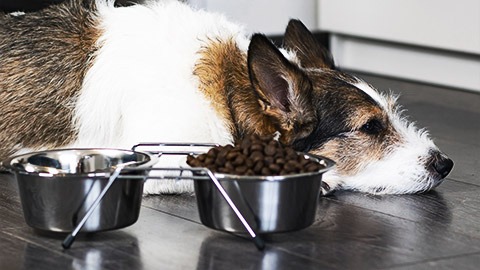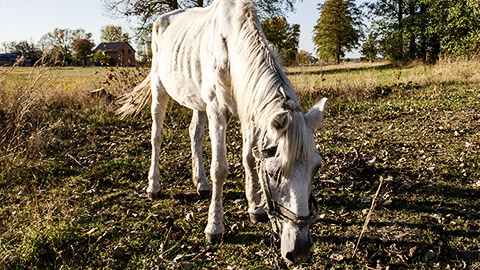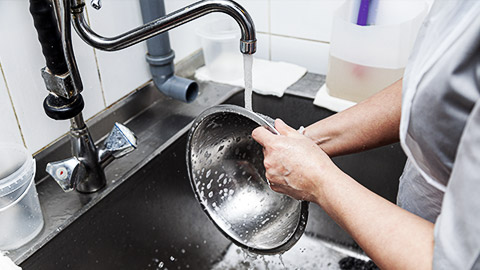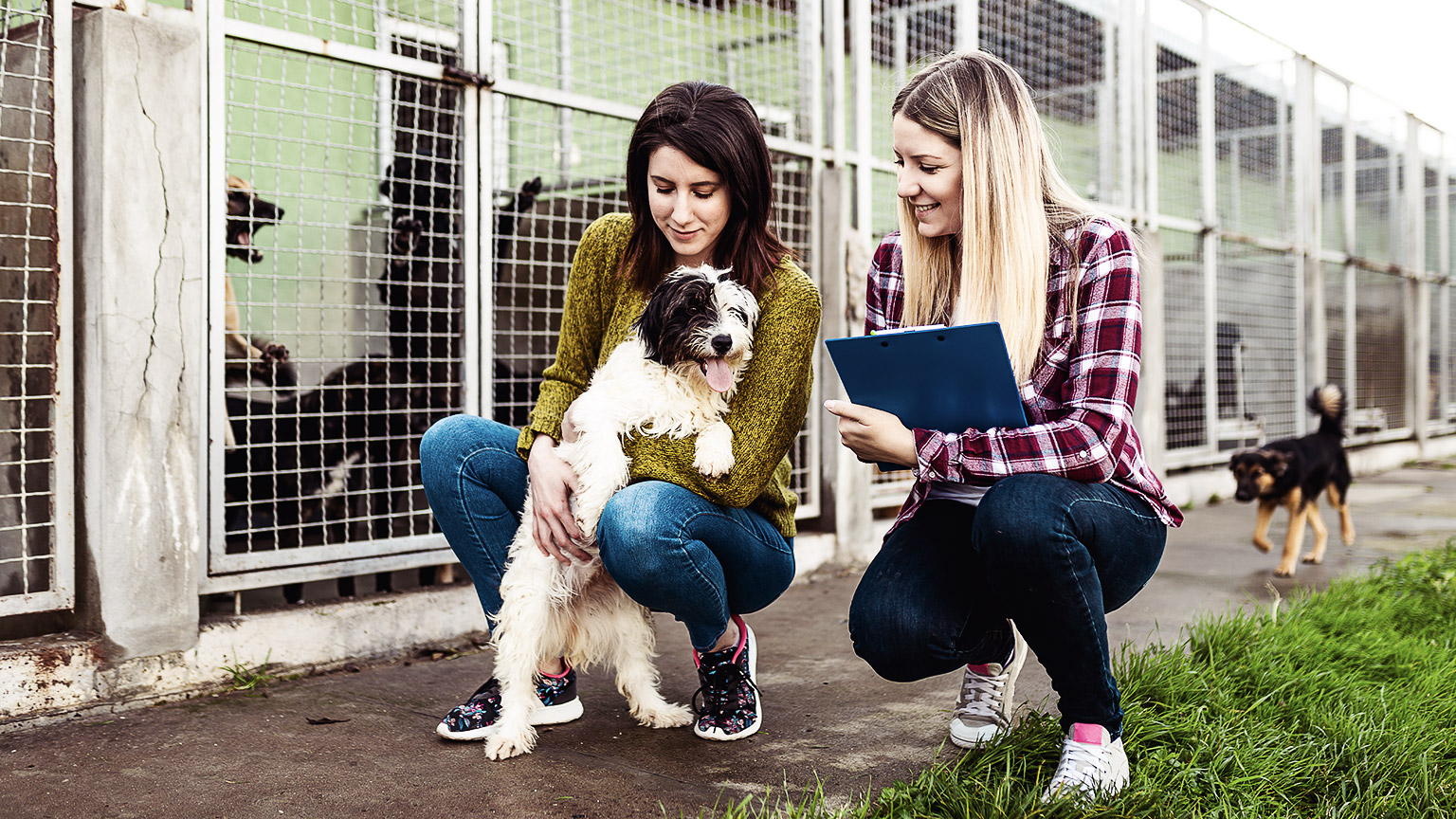Recording information is an important part of your role as an animal carer. It allows you to share information with other staff members and raise concerns, if you have any.
In many organisations, it is the responsibility of the veterinarian, manager or supervisor to record daily observations in the animal’s main file each day. However, your organisation may be different, so you will need to ensure that you are aware of the policies and procedures if you need to complete this recording task.
At the very least, you will be required to record basic observations around the feeding and watering of the animals.
Feeding and watering records
Recording what the animal was fed and when is important because it allows you to keep track of which animals have been fed. This may be especially important if there are many animals to be cared for or if there are multiple staff responsible for feeding them. Maintaining clear feeding records will help prevent animals from being skipped or accidentally fed twice.
The specific information required, as well as how you record it, will depend on your specific workplace. You may record it on the cage card, individual feeding plan, detailed file, daily noticeboard or by some other method. Simply follow the requirements of your workplace.
As discussed in the previous topic, there are eight (8) common things that you may need to observe and record about how a particular animal eats and drinks:
- The time you provided food and water
- The type of food (and fluid, if not water) you provided
- The amount of food and water you provided
- The amount of provided food and water that was consumed by the animal
- Whether the animal has difficulty obtaining the food, chewing or swallowing food and/or water
- Any patterns in eating habits and behaviours
- Variations or abnormalities relating to individual eating and drinking patterns, such as vomiting
- Whether the animal has defecated or urinated (as an indication of the animal processes nutrients).
The bottom section of the following cage card is one example of how feeding and watering may be recorded.
Ramona

| ABC All Animal Boarding | ||||||
|---|---|---|---|---|---|---|
| Animal name: Ramona
|
Owner name: Petrie Owner number: 0400 700 700 |
Species: Feline Breed: Devon Rex Age: 5 years Colour: Champagne |
Sex: Female Desexed: Yes Weight: 3.2 kg |
|||
| Stay | Feeding | Services | ||||
|
Date in: 08/07/2022 Date out: 20/07/2022 |
Product: Advance Adult Indoor Chicken (dry) Amount: 1/3 cup per day Frequency/timing: Morning Product: Advance Adult Indoor Turkey (wet) Amount: 1 packet per day Frequency/timing: Morning and evening |
Hydrobath - flea/tick: No Hydrobath - medicated: No Hand bath: No |
Clip (details): No Nail clip: Yes |
|||
| Vaccinations | Preventative health | Medication / supplements | ||||
|
Due date: 01/02/2023 Type: F5 |
Product: Revolution Spot On Due date: 13/07/2022 |
Product: PAW Digesticare Dose: 1/2 scoop daily Timing: Evening, on food |
||||
| Notes: | ||||||
| Date | Eat | Drink | Urine | Faeces | Medication | Notes: |
| 08/07/2022 pm | ✔ all | ✔ | ✔ | ✘ | ✔ PAW Digesticare | |
| 09/07/2022 am | ✔ most | ✔ | ✔ | ✔ | ||
| 09/07/2022 pm | ✔ all | ✔ | ✔ | ✔ | ✔ PAW Digesticare | |
Eating and drinking behaviours
kilograms (numeracy) As discussed in the previous topic, the eating and drinking behaviours of an animal may be an indication of their general health and wellbeing. For example, fussy eaters may become malnourished if they regularly refuse certain types of foods.
Changes in eating and drinking behaviours can sometimes be a sign that an animal is unwell. For example, suppose a dog that normally eats well suddenly refuses all dry food and bones. The concerned owner takes the dog to the veterinary, who discovers the dog has damaged teeth.

In order for you, as an animal carer, to notice a change in feeding and drinking behaviours, you must first learn the typical behaviours of the animals you care for. This is why it is important to record all eating the drinking behaviours, not just the unusual ones.
Unless you were familiar with the typical behaviour for that animal, you might not know if the dog from the previous scenario was refusing to eat dry food because it was used to wet food, it didn’t like that variety of dry food, it didn’t typically eat much at that time of day, or if there was something wrong with the animal.
If you do observe a change in usual behaviours, you must record the changed behaviour and inform your supervisor, who then may refer it to a veterinary practitioner.
You may be required to take detailed feeding observations on some animals, such as those recovering from surgery or with severe health problems. These detailed observations may include removing and accurately weighing or measuring any food remaining from the previous feed and using that information to calculate the amount of food (or water) consumed.
Serious feeding abnormalities
Serious abnormalities in feeding behaviours should be recorded and reported as soon as possible.
Serious eating and drinking abnormalities may include:
- Changes in feeding behaviours:
- Gorging
- Increased water intake
- Reluctance to eat
- Reluctance to eat previously accepted feedstuffs
- Hording or hiding food
- Difficulty eating, such as difficulty swallowing, chewing, or acquiring food.
- General observation of sick animals including:
- Rapid weight loss
- Vomiting or regurgitation
- Bloating
- Changes to faeces consistency, colour or amount.

Change in faeces often follows a change in eating habits
The amount, colour and consistency of animal faeces is often a very good indicator of the animal’s health. A sudden change in an animal’s faeces can let you know that something is going on with that animal.
The faeces of different animals look different. So, there is no one single characteristics to look for in all animals. However, ‘poo charts’ can be useful to refer to when you are unfamiliar with a particular anima’s faeces. Have a look at Oxbow Animal Health's example of a guinea pig and rabbit faecal chart in their article, 'The Scoop on Small Pet Poop: Normal, Abnormal, and Everything in Between'.
Knowledge check 8

Pack up and clean up
Now that you have fed, watered and observed the animals, it is time to pack up and clean up. It is extremely important to maintain the highest level of hygiene and to clean and store all feeding equipment correctly.
Storage requirements for animal food
Storing food in an animal care facility is equally as important as storing food in a human care facility. It is important that you understand that incorrect storage of food can cause spoilage and food poisoning.
The following are a few key things to remember when storing animal foods:
- Food should only be stored in areas that are designed for that purpose. This includes food stored in refrigerators, freezers, cool rooms, dry store, transport vans and refrigerated vans.
- High-risk food should be kept at or below 5°C, or above 60°C to avoid the ‘temperature danger zone’, where bacteria multiply fastest.
- Do not refreeze food that has already been frozen and thawed.
- You should always store raw food separate from cooked food.
- Store foods in the original packaging, if possible, with an airtight covering if necessary or in clearly labelled, airtight container to protect the food from contamination, such as pests and mould.
- Where food containers are used, ensure they are food grade and not damaged.
- Check the use by and best before dates:
- Dispose of any food at or past its use by date.
- Follow your workplace procedure for foods at or past their best before date. You may need to use that food within a specified period or throw it away.
Storing food in appropriate conditions and containers
All dry food, such as pellets, bird seed and hay, should be stored at room temperature (25°C or less) in a clean, dry, sheltered area. Open bags of dry food and small amounts of loose hay should be stored in an airtight container for the following reasons:
- To ensure the food stays fresh, otherwise it can spoil or go stale.
- To keep the food dry and prevent it from becoming contaminated by moulds and mildews.
- To prevent pests, such as rodents or insects, from eating or contaminating the food.
Any packaged dry foods, such as pellets or bird seed, must be disposed of once they reach their use by dates, even if they are unopened.
Unopened wet food should be stored at room temperature in a clean, sheltered area until opened. Open cans and packets of wet food must be:
- covered with an airtight lid or placed into an airtight container
- labelled with the date it was opened
- refrigerated.
To prevent food poisoning, you must throw away any uneaten wet food three days after opening.
Uncut fresh fruit and vegetables can be either stored at room temperature in a secure, clean container out of direct sunlight, or refrigerated. Fruit and vegetables can remain fresh for several days. Cut fruit and vegetables should be stored in an airtight container in the refrigerator.
Airtight containers prevent wet food from becoming contaminated by bacteria, fungi and other pathogens. The low temperature inside a refrigerator or freezer significantly slows down the growth of any bacteria that is naturally present in the food and reduces the risk of food poisoning.
The following video (1:14 mins) contains a couple of important tips for storing horse feed appropriately.
Bacterial contamination
Bacterial contamination is a very common cause of food poisoning. When cleaning food preparation surfaces and equipment and storing animal foods, it is critical to understand the main causes of bacterial contamination and how to prevent them. In food handling industries, the acronym FAT TOM is used to help remind staff about the prevention of bacterial contamination. Select each of the following headings to learn more about the six most common causes of food contamination and how to prevent them (Unilever Food Solutions, n.d.).
Food that is particularly high in protein (such as beef, chicken or fish) or carbohydrates (such as pasta or rice) serve as a breeding ground for bacteria. Therefore, it is important to know the type of animal food that is being used in the workplace and its nutrient make-up.
Bacteria is usually killed by acidic environments. Conversely, bacteria thrive in foods that have low acidity (such as chicken, fish and eggs).
Bacteria grows fastest in temperatures between 5°C and 55°C. As a result, this temperature range is often referred to as the temperature danger zone (TDZ). To prevent contamination:
- store food below 5°C
- cook it at temperatures higher than 55°C.
Following on from the previous point, risky foods should not be left in the TDZ for more than 4 hours because many microorganisms start to produce toxins after this period of time.
Most microorganisms need oxygen to grow and reproduce. Covering food or sealing it in airtight containers helps reduce the amount of oxygen available.
Microorganisms tend to grow and reproduce more quickly in moist environments, such as meats, eggs and cooked foods. So, it is important to store moist foods in airtight containers and at low temperatures.
Use by and best before dates
Check for use by and best before dates on any open foods. Check to see if your workplace has a disposal policy for foods past their best before date. If so, follow the procedure. If not, try to use up foods at their best before dates as soon as possible.
Dispose of any open food at or past the use by date.
When you restock food items, check the use by and best before dates. Ensure the items closest to their expiry dates are closest to the front of the shelf. That way those items will be opened and used up before the items with a more distant expiry date.
Changing the physical position of food items according to their use by or best before date is called stock rotation. For food items that do not have a use by for best before date, such hay or fresh fruit and vegetables, rotate stock using the first in, first out (FIFO) principle. This means that newly purchased items should be placed at the back, while older items are moved to the front to make sure they get used first. Stock rotation minimises waste by helping make sure food is used before it goes out of date or spoils.
Maintain a clean food preparation area
All feeding equipment is to be:
- cleaned with a scrubbing brush in hot water with dishwashing detergent or an appropriate hospital-grade cleaning agent.
- dried with a cloth or paper towel or allowed to air dry. Before putting any feeding equipment away, you must ensure that it is completely dry and free from contaminants.
- stored in a cupboard protected from anything that can contaminate them, such as dust, dirt, splashed water or urination.
Ensure that all food preparation and storage surfaces, such as benches, walls, floors, ceilings and shelving, are thoroughly cleaned with an appropriate cleaning product as well.
Dispose of any used gloves.
Safe use of chemicals and cleaning agents
It is essential that you keep your work areas clean at all times to prevent contamination, the growth of bacteria and to eliminate any slipping hazards.
Make sure all work surfaces, materials, equipment and instruments are cleaned, disinfected and sterilised, where required, in accordance with infection control guidelines. This will help prevent the transmission of zoonotic pathogens. All chemicals and cleaning agents should be handled correctly, using the correct PPE. Manufacturer instructions should be followed when mixing or handling chemicals.
Animal droppings as hazardous waste
In an animal care facility, hygiene is very important. When you attend your animal care facility, ensure you understand the protocols and regulations relating to hazardous waste disposal. Disposal of waste requirements may include disposal in accordance with:
- environmental protection (waste management) policies and regulations
- Australian and New Zealand standards.
A common example of hazardous waste in animal care facilities is the faecal waste of animals. Animal droppings harbour disease-causing organisms such as bacteria and worms. The clean-up of animal droppings is important for infection control and for the overall well-being of the animals. The longer droppings are left on the ground, the more likely it is for cross-contamination with feeding surfaces or spreading infectious diseases between animals. For this reason, animal droppings should be cleaned up as soon as possible and must be disposed of correctly.
Correct disposal of animal faeces
When feeding the animal, you need to ensure the food and water are not contaminated, such as by the animal walking their own faeces through their food. It is your responsibility to collect and dispose of animal faeces. Disposal of animal faeces should occur per your organisation’s policies and procedures and local and state council requirements. Animal waste should not go in the ‘normal’ bin in an animal care facility.
Some animal care settings, with many animals, are required to have an animal waste disposal tank or container. They are typically placed in a convenient location in the facility and generally have a foot-operated lid to make them easy and hygienic to use. Animal waste containers come in various sizes to suit different types, sizes and numbers of animals.
Most cats in an animal care facility will use a litter tray. You can collect the solid matter and dispose of it while leaving the uncontaminated litter in the tray.
Contaminated cat litter needs some consideration. Many facilities use biodegradable litter. This type of litter breaks down easily. Dispose of contaminated litter according to your workplace policies and procedures.
When collecting and disponing animal faeces, remember to wear appropriate PPE.
Record food and food supplement stock levels and report to supervisor
All food packaging and supplements that are opened for an animal must be recorded. Some organisations will have a computerised stock management system that will help you record the addition or removal of stock. Other organisations will have manual stock inventory sheets.
Regardless of the type of system, all organisations will track the level of stock on hand. A food and supplement stock inventory tells you:
- The reorder level for each item
- Where stock has been issued, by department
- The value of stock that has been issued
- The value of the stock-on-hand
- The maximum amount of each item that can be ordered at any time
- When that stock was issued.
It is common for a manual system to be physically located with the stock items. As with any aspect of stock control, the speed of noting stock movement and accuracy in recording its movement is essential. This means that the stock movement should be recorded as and when it happens. It is not acceptable to only record stock movement once every week, or month.
Maintaining food stock inventories
How do the records assist you in making sure that stock levels are maintained? Records are essential so that consistency in figures can be maintained, and any discrepancies can be sourced and evaluated.
When maintaining stock levels in your organisation, consideration needs to be given to a number of factors, such as:
- What is the ideal level of stock for the product?
- How much space is available for stock storage?
- How often the stock is reordered, in other words, what is the reorder cycle?
- Is it easy to adjust stock levels without suffering loss?
- What is the demand for the product?
- What is the availability of supply?
The basic assumption behind maintaining optimum stock levels is to avoid an ‘out of stock’ situation where a food item or supplement is unavailable for an animal that requires it. However, storage space may be limited, and some food items have relatively short expiry dates. So, it is a fine balance making sure there is enough stock on hand to properly feed the animals, without having so much stock that some of it goes out of date before it can be used.
Many animal care facilities will set a numerical minimum, maximum and reorder stock level for items.
- The minimum level is the absolute smallest amount of a food or supplement items that can be on hand.
- The maximum level is the most of any item that is to be in storage at any time, regardless of any deals that may be available from suppliers, and regardless of other factors (such as possible impending strikes, supply shortages).
- The reorder level is the set level stock must fall to before new stock can be ordered in. This reorder level (and reorder quantity) removes discretion from ordering and guarantees food or supplement items won’t run out.
It is important that once you recognise that the stock on hand is at a reordering level, you alert your manager or supervisor, who will then order more stock. If at any point you are unsure about stock ordering or any procedures that your organisation has in regard to stock, seek assistance from your supervisor or manager.
Food stock record sheet
The following table is an example of a basic manual food and supplement stock inventory.
| Date | Item description | Quantity on hand | Expiry date | Reorder | Signature |
|---|---|---|---|---|---|
| DD/MM/YY | Specific name of product | Exact number of unopened items | Specific use by or best before date | Refer to the reorder level for that item and indicate whether it has been reached | Your name |
| 22/07/22 | Supercoat Chicken Large Breed Adult Dog Food – 18 kg | 16 | Use by 10/2023 | No | Jane Smith |
| 22/07/22 | Petz Park Probiotic for Dogs – 180 scoops | 2 | Use by 02/2022 | Yes | Jane Smith |
Knowledge check 9
Complete the following two (2) tasks. Click the arrows to navigate between the tasks.
Well done! You have now completed the theory for this module. You should now have the skills and knowledge required to prepare, distribute and store food and water for animals safely and appropriately, according to animal dietary needs and workplace requirements.
The key concepts from this module include how to:
- Understand and correctly interpret feeding plans to:
- confirm the animals to be fed
- identify and prepare required foods and supplements.
- Provide food, water and supplements to the animal according to their feeding plan, in a manner that is safe for you and the animal
- Monitor animals to ensure they a feeding effectively and to identify and report any changes to feeding behaviours
- Clean and store food preparation areas and equipment to maintain safety and hygiene
- Record food and supplement stock inventories and report them as required.
Now that you have completed the theory, you can start preparing for the Structured Workplace Learning and Assessment for this module. Make sure you:
- Have access to three different animals of two different species and two different life stages
- The understanding and skills to confidently and appropriately feed and water those animals.
The following links may be helpful to extend your knowledge or support your interest in the care of animals.
- It may seem a simple task to weigh an animal. However, not all animals will sit on a scale by themselves or sit still long enough to obtain an accurate weight. The video, How to Weigh Your Rabbit (2:35 min), shows some handy tricks. This technique would apply to a variety of animals.
- The Captive Reptile and Amphibian Husbandry Code of Practice (pdf) from the Queensland Government provided detailed information regarding the feeding and watering of a range of common captive reptiles and amphibians.
